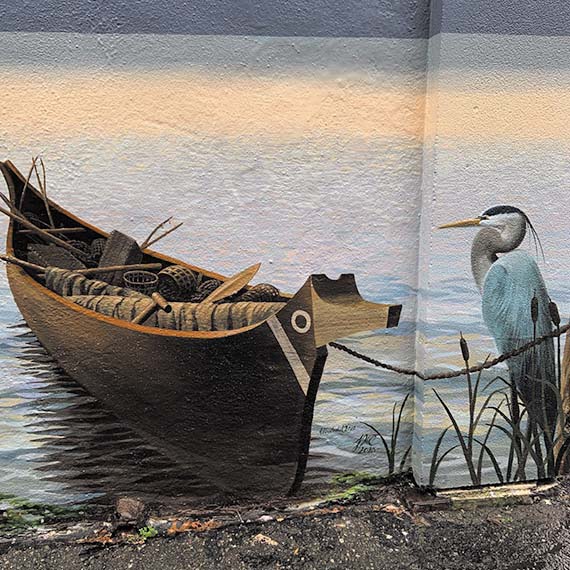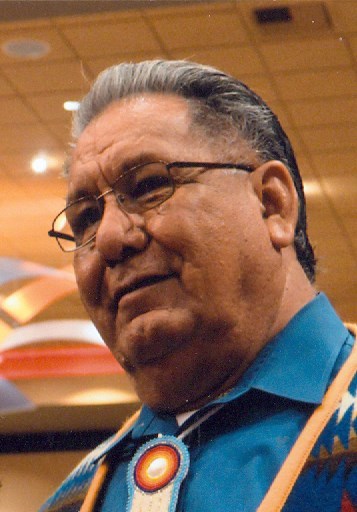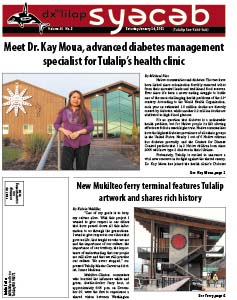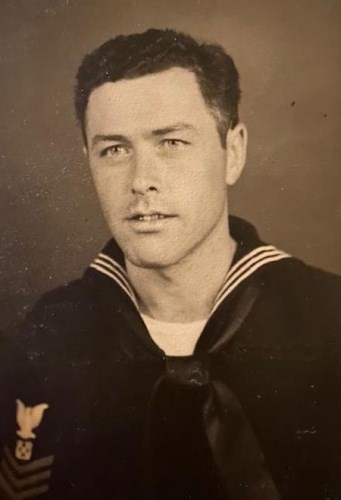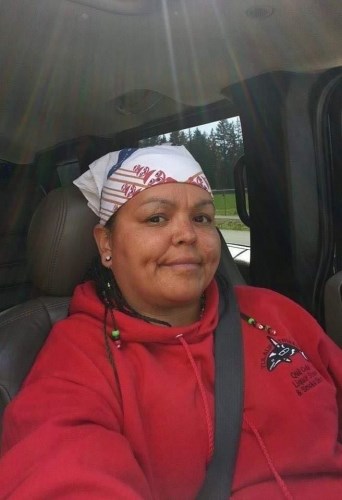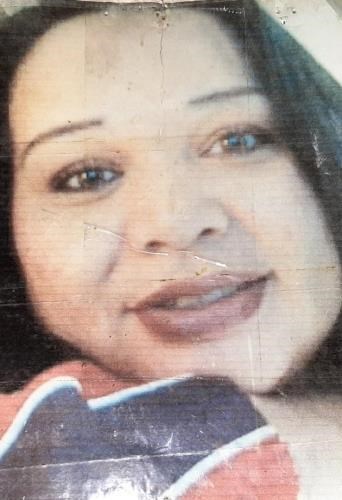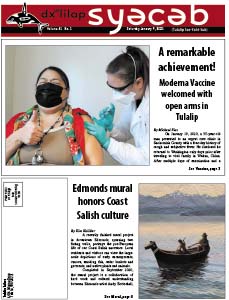
Author: Kim Kalliber
Gerald Duane FRYBERG Sr.
MAY 12, 1943 – JANUARY 16, 2021
Sunrise May 12, 1943 Sunset January 16, 2021 Gerald D Fryberg, Sr. 77, of Tulalip WA left our world on January 16, 2021. He was born, raised and lived his life on the Tulalip Reservation. Born to Martin Fryberg and Josephine Hatch Fryberg on May 12, 1943.
He was the first Tulalip Tribal member to complete the Federal Indian police academy in New Mexico and the first Tulalip Police Officer. He is known for being the Security Director at the Tulalip Bingo and then for the Tulalip Casino Resort until he retired.
He is survived by his wife Sammy Kaye Fryberg of Nez Perce; Eleven children. Brothers Billy (Sharlene) Dean Fryberg, Sr., Marlin Fryberg Sr., Cyrus (Karen) Fryberg and Sister Jeanette Fryberg. Special Niece and Nephew Marci Fryberg and Marlin Fryberg Jr. Hunting nephew Dennis Allman and children 50+ Grandchildren, 61+ Great Grandkids. Numerous Great great Grandkids, nieces and nephews. He is preceded in death by his Parents Martin Fryberg and Josephine Hatch Fryberg; Byron Fryberg, Sr., Myron Fryberg Sr. LeRoy Fryberg Sr., LeRoy Fryberg Jr., Clarence Hatch; Gerald Fryberg III (Handsome), Clinton Fryberg, Amelia Spencer; Anita Maurice; Baby Boy Spencer, Melvin Boehme, Christopher Boehme.
Graveside Service at Mission Beach Cemetery on 1/21/2021 at 9:00 AM
January 16, 2021syəcəb
Meet Dr. Kay Moua, advanced diabetes management specialist for Tulalip’s health clinic
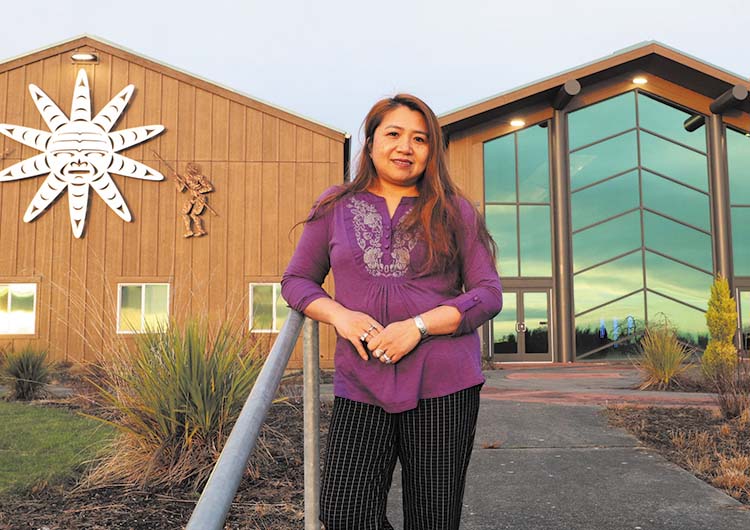
By Micheal Rios, Tulalip News
Native communities and diabetes. The two have been linked since colonization forcibly removed tribes from their ancestral lands and traditional food sources. Ever since it’s been a never ending struggle to battle one of the most challenging health problems of the 21st century. According to the World Health Organization, each year an estimated 1.8 million deaths are directly caused by diabetes, while another 2.2 million deaths are attributed to high blood glucose.
It’s no question that diabetes is a nationwide health problem, but for Native people its life altering effects are felt at a much higher rate. Native communities have the highest diabetes prevalence of all ethnic groups in the United States. Nearly 1 out of 6 Native citizens has diabetes presently, and the Centers for Disease Control predicts that 1 in 2 Native children born since 2000 will have type 2 diabetes in their lifetime.
Fortunately, Tulalip is excited to announce a vital new resource in its fight against the shared enemy. Dr. Kay Moua has joined the health clinic’s Diabetes Care and Prevention Program. An advanced diabetes management specialist, she brings a treasure trove of experience and cutting edge knowledge. She is well regarded for her expertise in the latest techniques and most effective practices for managing and preventing diabetes.
Dr. Kay was gracious enough to be interviewed by syeceb staff in order to introduce herself, her medical background, and what she hopes to accomplish in Tulalip.
SYS: You have a unique cultural background. Can you tell us about it?
I was born in Laos, and my ethnicity is Hmong. My family migrated to a refugee camp in Thailand after the Vietnam War and came to the Unites when I was 11-years-old. I started learning English (e.g. the alphabet, colors, numbers) in 7th grade.
My husband and I have been married for 30 years. We have 4 children, 3 boys and 1 girl. We are family-oriented people and love to host. My husband is the oldest of seven siblings, so we’re always surrounded with family and friends. My in-laws live on the same property, which is common for us to have multigenerational living in the same house. My mother-in-law is a Shaman, so we still perform traditional rituals and practices.
SYS: Please describe your educational journey to become Doctor Kay.
I’ve worked in the medical field since graduating High School. My first job was in a family practice where I started as a receptionist, then later trained in back office work, which included billing and rooming patients. I attended a community college while working full-time. After completing my AA degree in Medical Office, I continued school in the pursuit of a nursing degree.
Once I graduated with my Associate Degree in Nursing and earned my license, I went to work as a Registered Nurse (RN) at Providence hospital in Everett. Seeing so many people come into the hospital with poor diabetes control motivated me to pursue my Nurse Practitioner license to help people living with diabetes. After attending graduate school, where I received my Master’s Degree in Nursing (MSN) and Advanced Registered Nurse Practitioner (ARNP) license, I joined the Endocrinology team at the Everett Clinic to care for patients with diabetes.
Even though I enjoyed my work very much, I knew that I need to get back to school to achieve my personal goal of having a doctoral degree. With hard work and dedication, I graduated with a Doctor of Nursing Practice (DNP) degree in 2015. I continued to take extra classes and trainings and was able to pass the National Board Certified-Advanced Diabetes Management (BC-ADM) certification the following year.
SYS: What motivated you to join the Tulalip Health Clinic and practice medicine for the Tulalip people?
Native Americans are one of the highest risk groups for the development of diabetes. I was surprised to find out that in the history of the Tulalip Health Clinic an Endocrinologist or someone like myself has not been available for the people of Tulalip without a referral to an outside facility. I am pleased to be one of the first contracted providers to manage patients utilizing devices like CGM and insulin pumps. These technologies have evolved over time and under my care and direction we will be offering these devices in 2021 to patients who have this interest in advanced diabetes management.
The Tulalip Health Clinic already has a successful Diabetes Care and Prevention Program. I love the fact that the program is able to provide so many activities to teach people about diabetes and keep the community engaged with the clinic. In fact, I’ve never came across another diabetes program that is so unique and able to provide so much for their patients. I want to work with the team to help expanding the diabetes program by offering advanced diabetes care to Tribal members, to ensure that their treatment is up-to-date with most current medications and have the option to use technologies to enhance diabetes management. Tribal members should not have to seek care outside the Reservation for diabetes treatments.
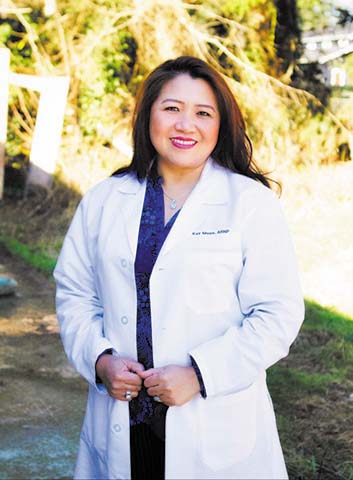
SYS: You specialize in advanced diabetes management. Can you explain what this means?
As I mentioned earlier, diabetes care has been my main focus from training during Nurse Practitioner school and my doctoral degree school. I’ve worked with patients with diabetes for over ten years. I continue to immerse myself with conferences and continuation education that’s specialized on diabetes to stay up-to-date with current medications and technologies and guidelines.
I’m an Advanced Registered Nurse Practitioner (ARNP) by trait, with a Doctor of Nursing Practice (DNP) degree and national Board Certified-Advanced Diabetes Management (BC-ADM) specialist. Patients are referred if they need to improve blood sugar control or have interest in insulin pump or continuous glucose monitor. Diabetes treatment is complicated and has to be individualized. I make sure that patients are offered the best and most appropriate treatment options available to the individual.
I also have extensive experience incorporating technologies such as continuous glucose monitors and insulin pumps to help patient improve diabetes control. Insurance requires additional documentations and special forms for approval. These technologies requires extra training and longer appointment time with patients that may not be feasible for general providers. This is why my service is required. I work with these devices every day and familiar with insurance requirements for quick approval.
SYS: With your extensive professional experience, what do you consider the biggest challenges to minimizing the diabetes epidemic?
Unfortunately, diabetes prevalence continues to increase every year. There are many contributing factors to this epidemic. I think our current financial economy posts many obstacles in diabetes prevention and treatment. Budget is tight in most households, especially with more and more people losing their job during COVID, leading to even more unhealthy diet and lack of exercise.
We all know the importance of a healthy diet. However, it may not always be feasible when you have a tight budget. Fresh food costs 2-3 times more than process food. People are working longer hours and don’t have time to cook, so they are eating more fast food. Combining processed and high fat foods with eating late at night contribute to weight gain, leading to increased insulin resistance or worsening diabetes control.
Healthy diet and routine exercise are the cornerstone of diabetes prevention and treatment. As people are working longer hours to make ends meet, they don’t have time to do anything else. Exercise is unlikely to be a high priority after a long work day. Lack of exercise increases fatty tissue, which causes insulin resistance and high blood sugar.
SYS: In your ideal scenario, how will your work positively impact the Tulalip community?
Diabetes management is complex and requires collaboration between the patient, their family members and the healthcare team to achieve best outcomes. As a new provider of the community, it’s important for me to learn the culture and incorporate the Tribal ways of living when making treatment plans. I believe getting to know the people, developing good rapport with patients, and building trust with the community are the key steps to improving diabetes control within the Tulalip community.
My understanding is that some tribal members have been going elsewhere for advanced diabetes care or have not been active in seeking diabetes care. My goal is to provide the most current diabetes treatment options for members living with diabetes right on the reservation. I will need to prove my knowledge and earn the trust of the community in order to draw members back to the Tulalip Health Clinic for diabetes management.
SYS: A principle of Native culture has always been holistic care (mind, body and spirit). Considering this, what advice or best practices would you suggest to combat diabetes and pre-diabetes?
I’ve always believe in holistic care approach. It is crucial to access and address the individual’s mental and physical health that may impact their ability to maintain diabetes management. Successful diabetes care also requires taking the time to access and get to know the patient, their family, their environment, and cultural practices and incorporating this information into individual treatment plans. We all have different cultural practices and traditional food that should be respected.
I’m so excited that the Diabetes Care and Prevention team has a garden to showcase and incorporate the Pacific Northwest native plants for natural medicines and herbal remedies. The Diabetes Program garden provides diabetes education and promotes traditional food, healthy eating, and activity. Healthy diet and staying active are important for everyone, but even more crucial for those who have diabetes or prediabetes.
My goal is to be a resource and provide guidance for patients who have diabetes or at risk of developing diabetes through obstacles like diet, exercise, blood sugar checking, or medication management. Uncontrolled diabetes can cause many unforgiving long-term complications. Diabetes can start to cause damage to internal organs in prediabetes state. Therefore, it is important to do everything you can to maintain good blood sugar control if you are considered high risk or as soon as you found out that you have diabetes.
My vision for the Tulalip Diabetes Program is to expand diabetes care to Tribal members with prediabetes. Historical records show that at least 20% of these patients convert to full blown type 2 diabetes yearly. We need to focus our attention on preventing diabetes in order to decrease the diabetes epidemic. I hope that we will be able to offer routine educational group classes on diabetes disease and have activities to promote healthy eating and active living once it’s safe to have group classes again. In the meantime, I encourage everyone to find safe activities to stay active and practice meal portion control.
SYS: Anything else you’d like to share to our readers?
Special thanks to Roni Leahy (Tulalip Diabetes Program Coordinator) for having the vision to expand the Diabetes Care and Prevention Program and entrusting me with this opportunity. I am grateful for the support from Dale Jones (Diabetes Program Advocate) and Brooke Morrison (Diabetes Program Assistant). I also like to thank the Tulalip Healthcare providers, Dr. Chad Cleven, Dr. Natasha LeVee, Dr. Howard Johnson, Dr. Rhonda Nelson, and Dr. John Okemah for welcoming me to the clinical team.
It is an honor and privilege to have the opportunity working with the Tulalip Health System. I look forward to learning the Tulalip culture, earning the trust of each patients and the community, and collaborating care with the clinical team to improve the health and quality of life of tribal members suffering from diabetes.
Harold Lewis “Uncle Mickey” Walker
November 7, 1916 – January 11, 2021
Uncle Mickey passed away peacefully on January 11th at the age of 104 surrounded by family. Mickey was born in Cleveland Ohio on November 7th 1916 and spent many years sailing the Great Lakes as a merchant marine. Anyone who knew Uncle Mickey heard stories of the massive waters of the great lakes and the adventures that filled him for a lifetime.
In 1941 Uncle Mickey began his service in the United States Navy where he served until 1945. He was a proud WWII veteran, and his whole family is proud of him.
Mickey married his love Ruth Coy a Tulalip Tribal member in 1946, they spent many years in Renton while he made a career with the Boeing Company. Uncle made friends everywhere he went and that included many from Boeing.
Mickey and Ruth made their way back to Tulalip where he retired from the Everett branch of Boeing. During this time Mickey and Ruth enjoyed being home in the Tulalip community; active at St. Anne’s Church, community ceremonies and partaking in traditional ways of being. Mickey was bestowed the title Honorary Tribal Member for his dedication and love for the Tulalip people.
Uncle Mickey moved to a remote area in Arizona and began to lead a simple life, taking walks and enjoying the outdoors and traveling the Southwest with Ruth. He was very independent all the way until the end of his life. Uncle Mickey was a proud man, honorable and had a wonderful sense of humor.
Uncle moved back to Tulalip 7 years ago and lived the rest of his life living with his nephew Lenny and spending time with family. Uncle Mickey is survived has numerous nieces and nephews who brightened up his life. He is preceded in death by his wife Ruth Walker, his parents, two brothers and a sister.
We would like to thank all the caregivers who helped make Uncles life full, happy and healthy over the last couple of years. We will remember Uncle Mickey’s smile for the rest of our lives, he blessed us until his last breath and will continue on for the rest of ours.
A graveside service will be held Thursday, January 14, 2021 at 12 Noon at Mission Beach Cemetery. Arrangements entrusted to Schaefer-Shipman Funeral Home
New Mukilteo ferry terminal features Tulalip artwork and shares rich history
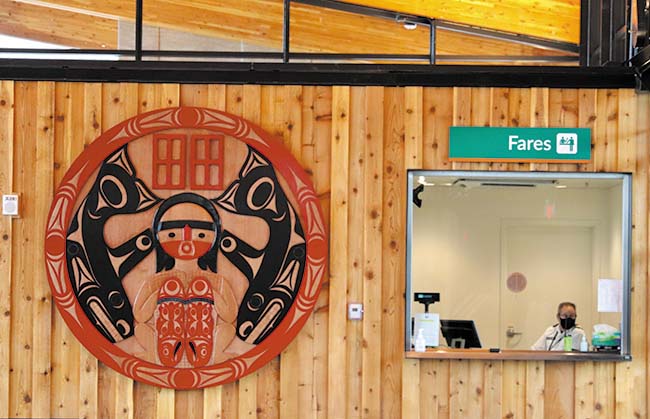
By Kalvin Valdillez, Tulalip News
“One of my goals is to keep my culture alive. With this project I wanted to give respect to our elders that have passed down all this information to us through the generations. I want to give respect to our elders that gave us life, that taught us who we are and the importance of our culture, the importance of our territory, the importance of understanding that our people are still alive and that we still practice our culture. We never stopped,” expressed Tulalip Master Carver and Artist, James Madison.
Mukilteo-Clinton commuters who boarded the infamous white and green, double-decker ferry boat, at approximately 6:00 p.m. on December 29, were the first to experience a shared vision between Washington State Department of Transportation (WSDOT), Washington State Ferries (WSF) and a handful of local tribes; Tulalip, Lummi, Muckleshoot, Nooksack, Samish, Stillaguamish, Snoqualmie, Swinomish, Suquamish and Sauk-Suiattle. After twenty years in the making, the project officially broke ground in 2019 and days before the start of 2021, the Mukilteo Multimodal Ferry Terminal opened their tollbooths to people traveling across the waterways to Whidbey Island.
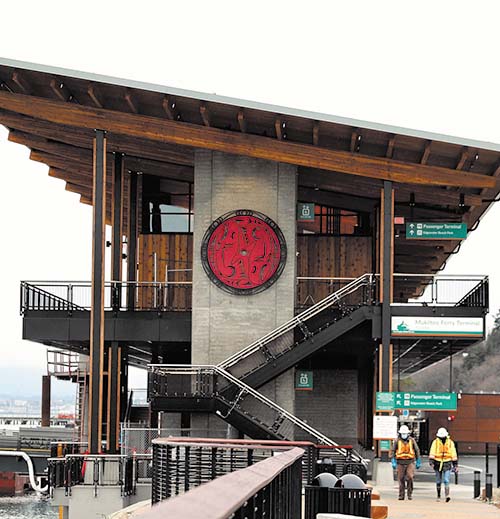
Said Phillip Narte, WSF Tribal Liaison, “This new facility sits on Indigenous lands where the Snohomish and other Indigenous peoples fished, hunted, and gathered for generations. Without the partnership of eleven federally recognized tribes, we would have not been able to build this facility.”
The debut of the new ferry terminal was a hot topic over the past several years. Highly anticipated and discussed amongst Washington State residents, government officials and tribal nations due to its location and the necessity of a new terminal to help address a plethora of issues the city of Mukilteo faced including traffic congestion and the safety of their townspeople and ferry riders. The previous docking station was in use for over sixty years as the state’s second busiest terminal, carrying 4 million travelers annually, and WSF anticipates over the next twenty years, the amount of foot passengers will increase by 100%.
“This project represents everything that matters to Washingtonians,” stated Washington State Governor, Jay Inslee. “The largest ferry system in the country has a new facility we can all be proud of – it is a symbol for the bright future we’re building here in Washington state.”
Previously, on any given day you could expect ferry-boarding traffic for miles, stretching from the sidewalk of Ivar’s Seafood Bar to Paine Field, but the new terminal aims to address that problem, now located a third-of-a-mile from the old station and off the main road. The terminal also includes closer drop-off and pick-up zones for bus passengers as well as a transit center for Sound Transit. Loading lanes have also been extended in both length and number of lanes, holding up to nearly 250 vehicles at a time.
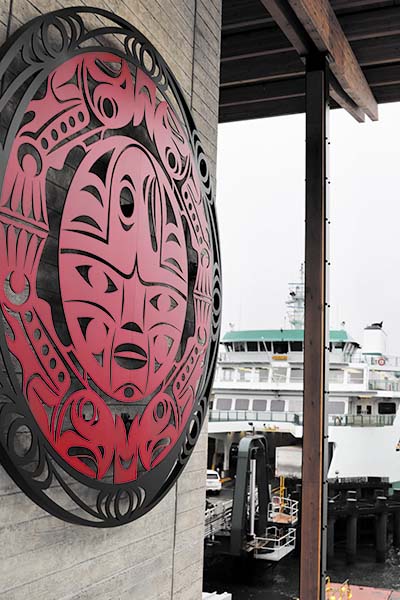
In addition to many new and exciting features, the terminal is located at a historic site, a location special to the tribes who frequented the Salish Sea long before the invention of ferries. People who called present day Mukilteo home since the beginning of time, harvested salmon and shellfish from its shores generation upon generation, and gathered at that location 165 years ago to sign the 1855 Treaty of Point Elliott.
That Treaty is a formal agreement between the federal government and the people who make up the central and north Puget Sound tribes, including the Snohomish, Snoqualmie, Skykomish and other allied bands. As direct descendants of the Snohomish, the Tulalips ceded millions of acres of land, agreeing to move their people to the present-day Tulalip reservation. In return, the Tribe retained their rights to fish in their usual and accustomed grounds as well as hunt and gather on open and unclaimed lands in order to continue practicing their traditional cultural lifeways.
“This project is a pretty big deal for me because I’ve fished all along here all my life,” said Joe Gobin, Tulalip Artist and Master Carver. “We used to go there with Stan [Jones Sr.] and my dad, Bernie Gobin. I was also on the Fish Commission for like 30 years, and we actually had to negotiate for that ferry terminal to even go in because we had to give up certain fishing rights. It was a long time ago. It didn’t happen overnight, we knew that going into the project. It took a lot of years. It took a lot of negotiation. And this is kind of what came out of it, they recognize that this is our land, Tulalip’s, not anybody else’s.”
Signage is posted along a walkway leading up the 5,865 sq. foot building that details the history and traditions of the Tulalip people, including information about canoes, treaties and longhouses. Drivers, foot passengers, and even locals out for a jog or walking their pets can learn about the Coast Salish lifestyle and journey, beginning with pre-colonial traditions, throughout the years of forced assimilation, and up until the current cultural resurgence that shows local tribes reclaiming their traditional language, songs, stories and practices, as evidenced by the many Lushootseed words and phrases displayed throughout the new terminal.
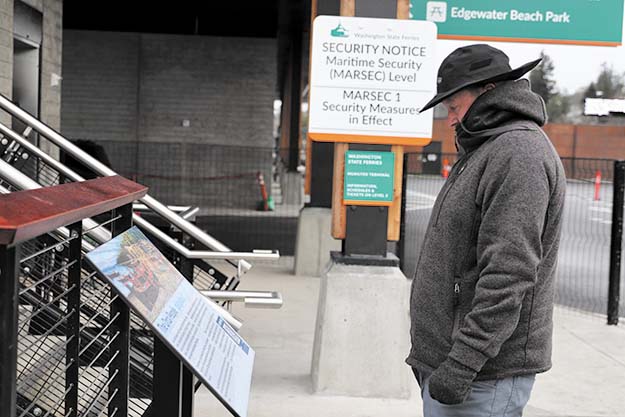
“I’m from Eastern Washington, that’s where I grew up, and it’s nice to see the history for people who may not have the biggest voice around here, so that folks that come through here can actually see what was here before white people,” said Everett resident, Paul Shelton. “I like that it’s true to the tribes that were here before everybody else and that they’re properly represented, that makes me feel good.”
The biggest attraction at the new ferry terminal, garnering a lot of buzz online, is the artwork commissioned by a number of artists who originate from the tribes that signed the Point Elliot Treaty of 1855, including several designs created by Joe and James. Over a dozen traditional and contemporary pieces are showcased at the terminal, which was constructed to replicate a traditional cedar longhouse.
“The longhouse idea, that might have been Hank,” explained Joe thoughtfully. “My cousin Hank Gobin was involved with all of that in the beginning before he passed. He did a lot of the groundwork, making sure that it was representative of our people in the right way. That’s how I approached this project, how I tried to do my artwork, representative of us; the killer whales, the salmon, our canoes.”
In total, Joe can be credited for six contributions; two metal spindle whorl designs located at each end of the building (one killer whale, the other salmon), one cedar spindle whorl on the inside of the building that depicts the traditional Tulalip Seal Hunting Brothers story, two welcome posts (one man and one woman) located near the restrooms, and a full-sized cedar dug-out canoe, which hangs overhead inside the terminal and faces a gorgeous ceiling-to-floor view of Possession Sound.
Many other magnificent Indigenous works are on display throughout the 400,000 sq. foot property such as carvings and weavings by tribal artists who represent other sovereign nations, like the welcome figures located at the tollbooth created by Suquamish artist Kate Ahvakana.
James also made two artistic contributions for the project that are unique in design, traditional in story, and personal in heritage. In each elevator shaft, extending both levels, are dual-sided glass displays that place you in an underwater world, a Tulalip story that James grew up with and heard his entire life.
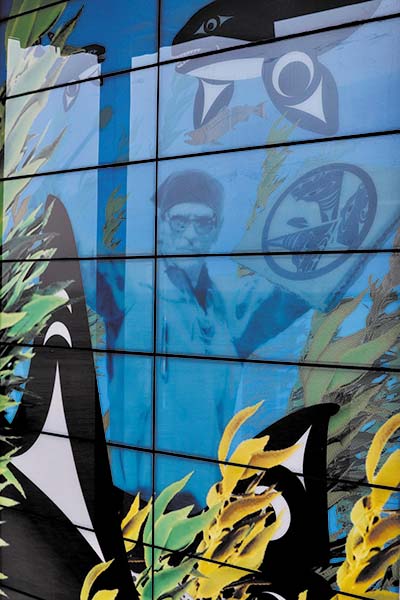
James said, “For me, it was important to speak from teachings that I learned from my grandfather. Teachings that he learned from his grandmother and from his uncle, who taught him in our old traditions and with our old stories. Those teachings have been passed down all the way to me. My art, the giant glass pieces, are kind of historical and are the very meaning of our existence in that area. My story is about the water people. It’s a story my grandpa, Frank Madison, told me many times about this village that was under the water; there used to be a longhouse under the water and we, the human beings and animals, all spoke the same language. I have a portrait of my grandfather in the water amongst the whales and the salmon, two important creatures to our people. And the other glass mural is of my grandfather’s mother, my great-grandmother Delia Jimicum. They’re all amongst the water people. There’s a longhouse in the background and that’s the water people’s longhouse.”
As the original caretakers of this land, Tulalip kept the sacred Salish waters and all of its inhabitants in mind during the early phases of planning for the new terminal. Going green and minimizing the carbon foot print was a shared interest, as well as a special request, from the city of Mukilteo. This resulted in several design features that will be ‘light on the earth’ like minimal overwater coverage so marine plants can thrive in their native waters, and a shed roof covered with solar panels for energy efficiency as well as to collect rainwater. The Terminal also focuses on the proper treatment of storm water runoff with rain gardens and ‘pervious concrete’ in the holding lanes. And soon, Washington State Ferries will be going electric, which is great news for the environment.
“Putting the whale and the salmon in my art was important,” James stated. “Not just because of stories that we passed on in our culture, but also to show the significance and importance of what the orca whale, we call it Blackfish, and the salmon mean to Native people in the Puget Sound. We need to take care of them, it’s been my mission to put that message out there. It’s so important for us to protect them because when they’re gone, we’re gone.”
Although the project required lots of dedicated hours from several parties and took multiple years to complete, everybody’s hard work could not be celebrated in-person together, unfortunately, due to COVID-19. Instead, WSF and WSDOT held a virtual ribbon cutting ceremony that featured commentary from many of the individuals who had hand in the project, and also numerous Washington State lawmakers like Governor Inslee and Senators Cantwell and Murray who are excited about the new terminal and its location’s rich Salish history.
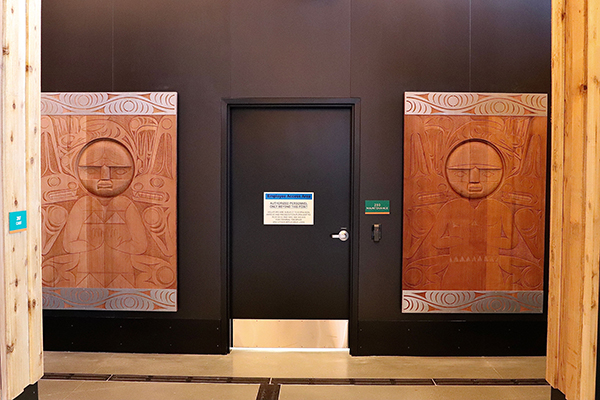
“I hope to see that all of this starts a trend when they start remodeling other ferry terminals and incorporate artwork by our people at all of them just like they do in Canada,” Joe expressed. “It kind of opens up the door for other artists, so hopefully the younger artists are watching and start getting involved in more projects like this. I’m kind of the old guy now, the eldest artist out there.”
James added, “It’s been a long, long time coming for this project. And being a part of such an important project on our very land that our people lived on and harvested from, is important to our people. A building like this is significant, not just because it’s our territory and it’s on our land, but because people get to intermingle with all the art and read it, and read about us and about the area and the territory. I think that this needs to be done everywhere in the Puget Sound region. My hands go up to the Tribe and our leaders. I hope I was able to represent our people in the best way that I could.”
Ami Ashli Pablo
July 19, 1978 – January 6, 2021
Ami Ashli Pablo of Tulalip passed away on January 6, 2021.
She was born on July 19, 1978 to Cheryl Enick and Eddy Pablo Sr.
Ami loved being out on the water crabbing and fishing with her family. She worked at the Tulalip Liquor store and Tulalip Bingo. Ami enjoyed and was a competitive pool player. She also worked as a stewardess on the Mt. Mitchell and traveled off to Alaska. She truly enjoyed just driving around and flipping everyone the peace sign with her bright smile and showing off her big dimples. She truly enjoyed spending time with her grand-children they were her whole world.
Ami is survived by her mother Cheryl (Dan) Enick and step mom Lori Parks.
Siblings/Brothers: Roy (Ananda) Pablo, Eddy (Sage) Pablo, Dean (Darlena) Pablo, Matthew Pablo and Kanim Henry; sisters, Tara and Leandra. Her Daughter Kia (Adam) Pablo
Grandchildren: Chuckie, Sheraylah, Penina, Avonna and one unborn grandchild on the way.
Numerous other family members and friends.
Proceeded in death by her Father Eddy Pablo Sr., Her brother James Pablo, and her son Dontae Wayne Jones. Her grandparents: James and Evelyn Enick, Leota and Louie Pablo Sr.
A graveside service will be held Wednesday, January 13, 2021 at 10:00 am at Mission Beach Cemetery. Arrangements entrusted to Schaefer-Shipman Funeral Home.
Tamara Lee Hayes
April 8, 1963 – January 4, 2021
Tamara Lee Hayes 57, went on her journey to our ancestors on January 4, 2021. Born April 8, 1963 to Merle A. Hayes II “Hillbillie Rocker Chuck” and April Smith (Marvin). A proud Tulalip Tribal member; living her amazing beautiful life on reservation. Her powerful smile and natural motherly support for all. Led her to become a great treasure box of cultural teachings, that her involvement, true dedication to her people/community was shared throughout Indian country.
She enjoyed and loved berry picking, storytelling, bingo slots, travel, never afraid of hard work, or to lend anyone a hand or hug.
Her treasure box of grandchildren “gems”, she was never afraid to share her gems and share her contagious humor with friends and family. Holidays “dinna” is where she shines, keeping us close and being such a great warrioress motivated her to become the best she could be simply make a whole room become one with just her presence. Tamara’s strength for our family came through her spirituality and faith in the Lord. She leaves a humble legacy and her true legend qualities with her daughters, where she lived with Cierra Williams they both raised her grandchildren together. Blessings to our awesome family, she appreciated and adored all her aunts, uncles, friends, and family which helped build her foundation.
Survived by, Father Merle A. Hayes II, Mother April (Marvin) Smith, siblings: Merle A. Hayes III, Carnagie (Tara) Hayes, Bernadette Abuan, Holliday Hayes (Antonio). Children: Courtney Solomon and Cierra Williams. Grandchildren: Owen A.J. Woods, Martine Tamara Solomon (Trevor), Wesley G.V. Solomon, Irene R.A. Solomon, Darrian L. Solomon, Pierce J. McCLellan, Christopher S. McClellan, Sophia Victoria Rose Williams. Great grandsons: Shawn Lee Solomon and soon to be great-grandchild.
Proceeded in death by her grandparents, aunts, uncles, cousins. Beloved Sophia Solomon and Edison McClellan Jr.
A graveside service will be held Monday, January 11, 2021 at 12 Noon at Mission Beach Cemetery. Arrangements entrusted to Schaefer-Shipman Funeral Home.
January 9, 2021 syəcəb
Edmonds mural honors Coast Salish culture
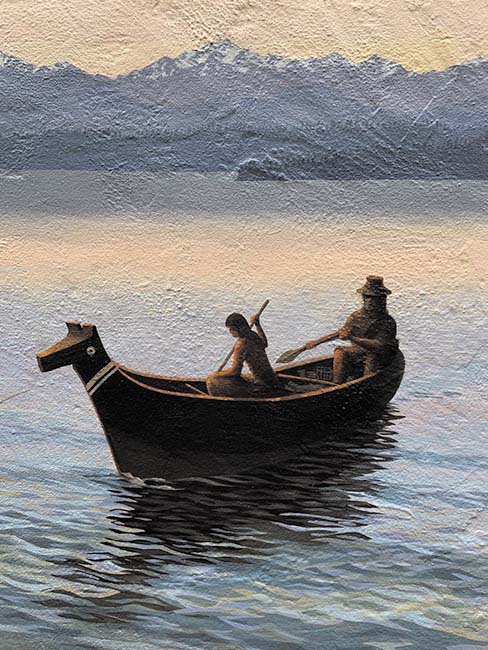
By Kim Kalliber, Tulalip News
A recently finished mural project in downtown Edmonds, spanning two facing walls, portrays the pre-European life of our Coast Salish ancestors. Local residents and visitors can view the large-scale depictions of early encampments, canoes, smoking fish, cedar baskets and garments, and native plants and animals.
Completed in September 2020, the mural project is a collaboration of hard work and cultural understanding between Edmonds artist Andy Eccleshall, and Tulalip tribal member artist Ty Juvinel. The project was organized by Mural Project Edmonds, a committee of Art Walk Edmonds.
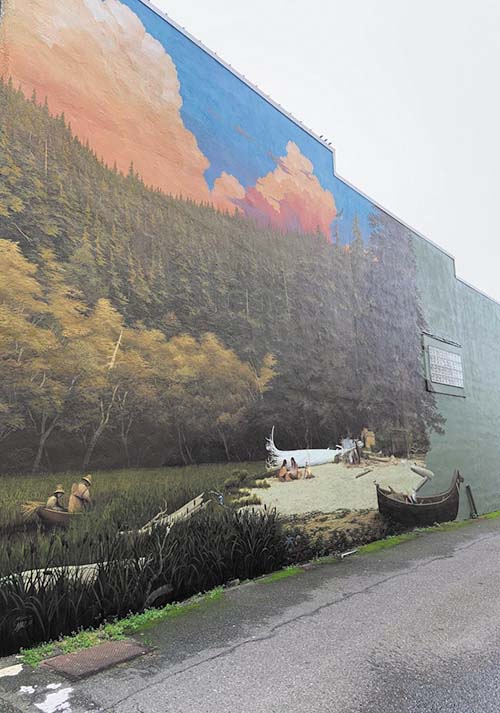
“I was approached by Andy because of the carving I am doing for the Edmonds Historical Museum, as well as various exhibits throughout Edmonds,” explained Ty. “Andy needed someone to create a mural that would represent the history of Edmonds and I mentioned the possibility of doing a mural depicting early contact, between fur trading.
“Andy did the amazing painting and I helped with the depiction,” said Ty. For more than a year, Ty shared history and photos with Andy, including a visit to the Hibulb Cultural Museum, to help him gain a better understanding of Coast Salish culture.
Everything from the way huts were constructed, the design and use of canoes, how cedar was used, traditional cooking methods and the inclusion of a woolly dog, were discussed by the two artists.
Ty explained that woolly dogs were bred for their long hair, which was perfect for weaving into blankets and other items.
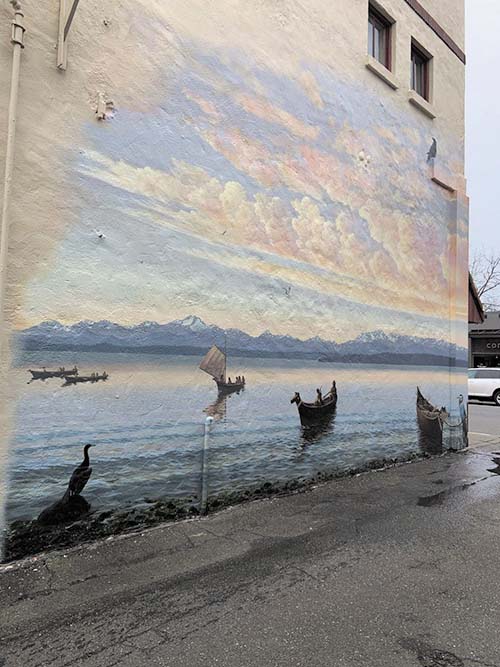
“One thing I like to mention, is Andy was told by a passerby that the women in the painting were wrong,” said Ty. “The passerby said they were wrong because their hair wasn’t matted and the hair shouldn’t be that nice. Luckily, I was there that day to dispel that claim, and educated them both that the Salish people bathed religiously, sometimes up to three times a day. Even during the winter, with cedar bow’s dipped in water and brushed against the body.”
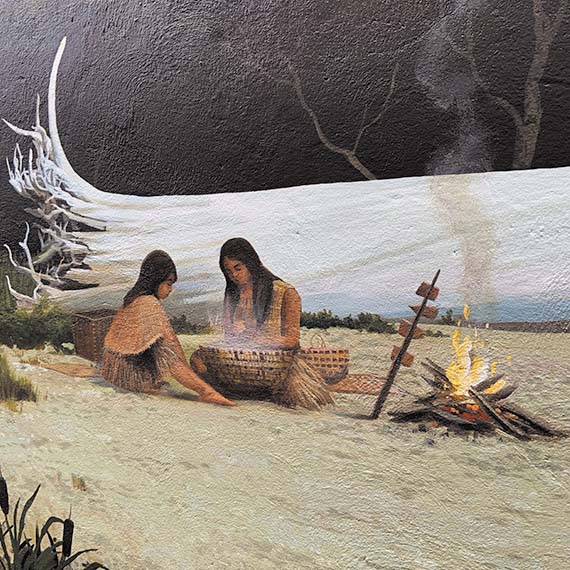
“That area of Edmonds used to be a marsh land, so I figured it may have been used as a summer camp area; summer foraging and prepping for winter,” explained Ty. “From there it was just trying to close my eyes and go back to those days of beach camps, elders teaching basketry, hunting, fishing, kids doing as they please, everyone is busy with their chores, preparing for the winter. I was hoping the idea of a community would be shown, and Andy shows it. Community is everyone bringing their resources and abilities together for the community. Again, Andy depicts this wonderfully. When I stand in front of this mural I feel like I’m waiting for them to come to life. The men on the water shouting ashore, the scent of the smoke mixed with salmon and gentle tides.”
Ty’s signature can be found, along with Andy’s, at the base of each mural.
“It was a joy to work within the Edmonds community. Every time I visit I’m welcomed as a neighbor and everyone seems very genuine. I look forward to my next visit,” added Ty.
The mural is located on facing walls in the alley between 4th and 5th Avenue in Edmonds, connecting to Main Street.
